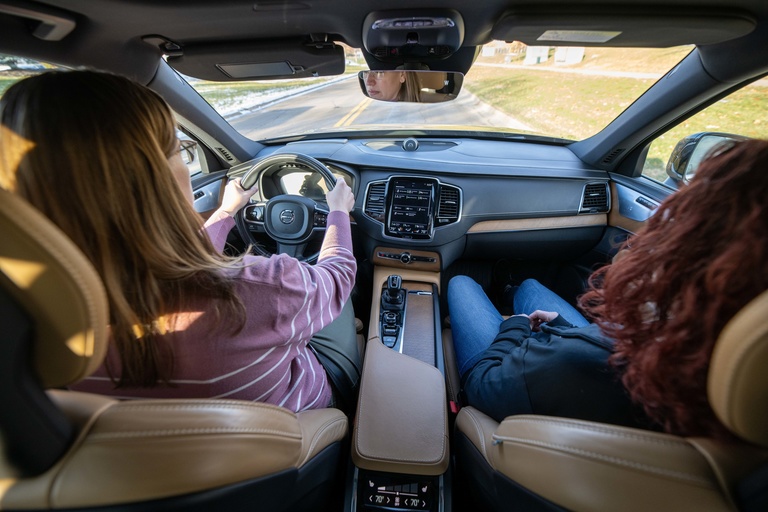Our investigators have been working on a series of studies analyzing advanced driver assistance systems (ADAS) technology and consumer understanding of ADAS features. ADAS features monitor the driving environment and may warn the driver of potential collisions (e.g., blind spot warning), provide intervention (e.g., automated emergency braking), or provide driving control assistance (e.g., lane centering assist).
Mapping driver understanding of ADAS technology
Sponsored by AAA Foundation for Traffic Safety and SAFER-SIM UTC
Survey results were collected from more than 2,500 drivers to analyze road users’ understanding of ADAS features. The survey assessed users on their understanding of adaptive cruise control and lane keep assist, and it identified their confidence levels in understanding these systems. When their understanding was compared to their confidence, researchers say you want people whose confidence matches their understanding (i.e., high confidence with strong knowledge, or low confidence with weak knowledge).
“Those who realize they have a weak understanding of ADAS and also lack confidence in their understanding, but who want to use this technology, may be more willing to seek out educational material,” explained Justin Mason, assistant research scientist. “However, those with high confidence but weak knowledge may be more prone to misusing the technology.”
Notably, the strong understanding group more often learned about ADAS via trial and error whereas the weak understanding group learned about ADAS via the owner’s manual. The findings from this project may help direct educational approaches in the future. For more details, watch the SAFER-SIM webinar or read the final report.
Consumer education for ADAS
Sponsored by Toyota Collaborative Safety Research Center (CSRC)
In a recently completed study, investigators looked at the impact of over-the-air (OTA) updates on drivers’ understanding of ADAS features and their performance.
Part 1 of the study: In the NADS-1 simulator, OTA updates were made to the vehicle’s system without any training to the drivers. This was meant to identify gaps in their understanding.
What they found: A more complicated OTA update that changed the driver’s role (i.e., increased automation) caused larger gaps in understanding, making it difficult for drivers to safely use the system. The addition of an automatic braking system resulted in smaller gaps in understanding.
Part 2: The results from Part 1 were used to design educational materials that were then tested in this second part of the study.
What they found: The educational material, which included information about the driver’s responsibility, was helpful when the system update was complicated. However, if the system update was simple, the education may actually decrease drivers’ confidence in their own understanding.
Advanced Driver Assistance Systems (ADAS) Education and Outreach
As part of the Behavioral Traffic Safety Cooperative Research Program (BTSCRP) administered by the National Academies, DSRI researchers are documenting and evaluating the state of training and education for ADAS features. Ultimately, the team’s findings will inform institutions, agencies, and practitioners responsible for driver education and training about tools, strategies, and models that can be used to provide consumers and other populations with a better understanding of ADAS technologies.
Phase 1 of the project involves collecting information about existing ADAS training or educational materials and then evaluating the material content and effectiveness. Specifically, the team will identify (1) gaps and errors in those materials, (2) the methods of delivery, and (3) populations in need of ADAS education and training.
Phase 2, which is slated to begin in 2024, will include synthesizing the information identified in Phase 1, identifying the characteristics of effective methods of delivering ADAS training and educational materials to target populations, and creating deliverables that include a practitioners guide and webinar for practitioners, such as Department of Motor Vehicle staff.
Crashes and near-crashes involving ADAS vehicles
Sponsored by the Iowa DOT and Colorado DOT
DSRI researchers are studying the role that ADAS features play in crashes or near-crash situations—including how ADAS systems may prevent or reduce the severity of crashes. Motorists involved in a crash or near-crash incident while driving a vehicle they believed was equipped with ADAS features complete an online survey about their experience, and of those, some are interviewed. The research team is also surveying or interviewing officers who complete crash reports.
“We’re looking to learn more about people’s experiences with the technology, as well as their perceptions and understanding of the features,” explained Michelle Reyes, senior research associate. “From officers, we are hoping to learn whether and how they consider potential ADAS involvement while completing a crash investigation.” The study’s findings will inform recommendations for various stakeholders, including state departments of transportation, vehicle manufacturers, crash reporting agencies, and law enforcement.
Student involvement

Graduate student Joy Kim worked on the Toyota consumer education project, collecting data and analyzing how people’s mental models translate from system to system. For example, how does training on adaptive cruise control in one vehicle translate when the driver uses a different vehicle? Kim is a PhD student in the industrial and systems engineering department. Her main research interest includes the safety concern surrounding the transfer of learning and knowledge gaps around new vehicle technologies. As part of her dissertation, she is continuing a deeper investigation into how experience and existing knowledge of a vehicle’s system impacts people’s understanding of ADAS after an over-the-air update.

Sabrina Vlk is an undergraduate mechanical engineering student and research assistant for DSRI. She has assisted with the Iowa DOT study concerning ADAS and crash/near-crash scenarios by helping the research team refine their motorist interview guide and protocol as well as correcting interview transcripts. Previous projects Vlk has worked on include Toyota’s Consumer Education studies, as well as NHTSA’s Temporal Components of Warnings study from 2022. Her work on this project consisted of developing study protocols, testing simulated drives in the NADS-1, briefing and debriefing participants, administering cognitive and mental model assessments, calibrating eye tracking software, and recording data from the control room.
This article originally appeared in the 2023 DSRI Year in Review.


